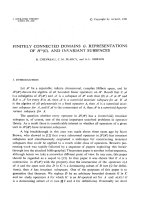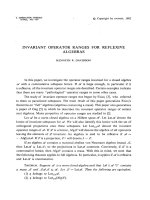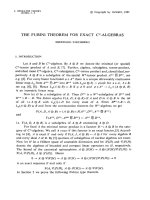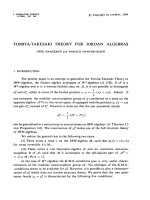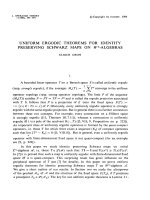Báo cáo toán học: "Ramanujan Type Congruences for a Partition Function" docx
Bạn đang xem bản rút gọn của tài liệu. Xem và tải ngay bản đầy đủ của tài liệu tại đây (93.04 KB, 9 trang )
Ramanujan Type Congruences
for a Partition Function
Haijian Zhao and Zheyuan Zhong
Center for Combinatorics, LPMC-TJKLC
Nankai University, Tianjin, P.R. China
,
Submitted: Nov 8, 2010; Accepted: Mar 1, 2011; Pu blished: Mar 11, 2011
Mathematics Subject Classifications: 05A17, 11P83
Abstract
We investigate the arithmetic properties of a certain function b(n) given by
∞
n=0
b(n)q
n
= (q; q)
−2
∞
(q
2
; q
2
)
−2
∞
. On e of our main results is b(9n + 7) ≡ 0 (mod 9).
1 Introduction
Recently, Chan [5 ] introduced the function a(n), which arised from his study of Ramanu-
jan’s cubic continued fraction. The function a(n) is defined by
1
(q; q)
∞
(q
2
; q
2
)
∞
=
∞
n=0
a(n)q
n
.
Throughout this paper, we assume |q| < 1 and we adopt the customary notation
(a; q)
∞
=
∞
n=1
(1 − aq
n−1
).
There are many similar properties between a(n) and the standard partition function
p(n), see [5–9, 11] for examples. One of the nice results of a(n) is the generating function
of a(3n + 2) obtained by Chan [5], which states that
∞
n=0
a(3n + 2)q
n
= 3
(q
3
; q
3
)
3
∞
(q
6
; q
6
)
3
∞
(q; q)
4
∞
(q
2
; q
2
)
4
∞
. (1.1)
This identity was also proven by Baruah and Ojah [1] using the 3-dissections for ϕ(−q)
−1
and ψ(q)
−1
, and by Cao [4] applying the 3-dissection for (q; q)
∞
(q
2
; q
2
)
∞
. We will give
another proof ba sed on identities of cubic theta functions in Section 2.
the electronic journal of combinatorics 18 (2011), #P58 1
Later, Kim [10] studied the following function ¯a(n) counting the number of overcubic
partitions of n,
∞
n=0
¯a(n)q
n
=
(−q; q)
∞
(−q
2
; q
2
)
∞
(q; q)
∞
(q
2
; q
2
)
∞
. (1.2)
In this paper, we are interested in the function b(n) defined by
1
(q; q)
2
∞
(q
2
; q
2
)
2
∞
=
∞
n=0
b(n)q
n
. (1.3)
Our main aim is to present certain arithmetic properties for b(n). In Section 3, we
will prove the following Ramanujan type congruence modulo 9, that is, for any n ≥ 0,
b(9n + 7) ≡ 0 (mod 9). (1.4)
We also establish two Ramanujan type congruences modulo 5 a nd 7 by using two classical
identities, that is, for any n ≥ 0,
b(5n + 4) ≡ 0 (mod 5), (1.5)
and
b(7n + 2) ≡ b(7 n + 3) ≡ b(7n + 4) ≡ b(7n + 6) ≡ 0 (mod 7). (1.6)
2 Preliminaries
In this section, we use cubic theta functions to obtain a 3-dissection of (q; q)
−1
∞
(q
2
; q
2
)
−1
∞
,
which repro duces Chan’s identity, and then give a number of facts that will be used in
the next section.
Now, let us recall the definition of cubic theta functions A(q), B(q), C(q) due to Bor-
wein et al. [3], namely,
A(q) =
∞
m,n=−∞
q
m
2
+mn+n
2
,
B(q) =
∞
m,n=−∞
ω
m−n
q
m
2
+mn+n
2
, ω = exp(2πi/3),
C(q) =
∞
m,n=−∞
q
m
2
+mn+n
2
+m+n
.
Borwein et al. [3] established the following relations which are useful to our proofs.
the electronic journal of combinatorics 18 (2011), #P58 2
Lemma 2.1.
A(q) = A(q
3
) + 2qC(q
3
), (2.1)
B(q) = A(q
3
) − qC(q
3
), (2.2)
C(q) = 3
(q
3
; q
3
)
3
∞
(q; q)
∞
, (2.3)
A(q)A(q
2
) = B(q)B(q
2
) + qC(q)C(q
2
). (2.4)
We now derive the 3-dissection for (q; q)
−1
∞
(q
2
; q
2
)
−1
∞
.
Theorem 2.1. We have
1
(q; q)
∞
(q
2
; q
2
)
∞
=
A(q
6
)(q
9
; q
9
)
3
∞
(q
3
; q
3
)
4
∞
(q
6
; q
6
)
3
∞
+
qA(q
3
)(q
18
; q
18
)
3
∞
(q
3
; q
3
)
3
∞
(q
6
; q
6
)
4
∞
+
3q
2
(q
9
; q
9
)
3
(q
18
; q
18
)
3
∞
(q
3
; q
3
)
4
∞
(q
6
; q
6
)
4
∞
. (2.5)
Proof. By (2.3), we see that
q
(q; q)
∞
(q
2
; q
2
)
∞
=
qC(q)C(q
2
)
9(q
3
; q
3
)
3
∞
(q
6
; q
6
)
3
∞
. (2.6)
From (2 .1 ) , (2.2) and (2.4), we find that
qC(q)C(q
2
) = A(q)A(q
2
) − B(q)B(q
2
)
= 3qC(q
3
)A(q
6
) + 3q
2
A(q
3
)C(q
6
) + 3q
3
C(q
3
)C(q
6
). (2.7)
By combining (2.6) and (2.7) together, we obtain that
q
(q; q)
∞
(q
2
; q
2
)
∞
=
qC(q
3
)A(q
6
) + q
2
A(q
3
)C(q
6
) + q
3
C(q
3
)C(q
6
)
3(q
3
; q
3
)
3
∞
(q
6
; q
6
)
3
∞
,
which is equivalent to (2.5) upon using ( 2.3) to simplify it. This completes the proof.
From the above theorem, we immediately have the following corollary.
Corollary 2.1. Identity (1.1) holds, and
∞
n=0
a(3n)q
n
=
A(q
2
)(q
3
; q
3
)
3
∞
(q; q)
4
∞
(q
2
; q
2
)
3
∞
, (2.8)
∞
n=0
a(3n + 1)q
n
=
A(q)(q
6
; q
6
)
3
∞
(q; q)
3
∞
(q
2
; q
2
)
4
∞
. (2.9)
Now, recall that Ramanujan theta functions ϕ(q) and ψ(q) which are defined as
ϕ(q) =
∞
n=−∞
q
n
2
,
ψ(q) =
∞
n=0
q
n(n+1)/2
.
We need several properties of these two functions stated as the following lemmas.
the electronic journal of combinatorics 18 (2011), #P58 3
Lemma 2.2.
ϕ(−q) =
(q; q)
2
∞
(q
2
; q
2
)
∞
,
ψ(q) =
(q
2
; q
2
)
2
∞
(q; q)
∞
.
Proof. The above two identities are consequence of Jacobi’s triple product identity. See [2,
p.11] for the detail.
Lemma 2.3.
ψ(q) = P (q
3
) + qψ(q
9
), (2.10)
ϕ(−q) = ϕ(−q
9
) − 2qQ(q
3
), (2.11)
where
P (q) =
(q
2
; q
2
)
∞
(q
3
; q
3
)
2
∞
(q; q)
∞
(q
6
; q
6
)
∞
and
Q(q) =
(q; q)
∞
(q
6
; q
6
)
2
∞
(q
2
; q
2
)
∞
(q
3
; q
3
)
∞
.
Proof. With series manipulat io ns, applying Jacobi’s product identity, it is not hard to
derive above identites and the detail is omitted here.
Lemma 2.4. If r
8
(n) and t
8
(n) are given by
ϕ(q)
8
=
∞
n=1
r
8
(n)q
n
,
ψ(q)
8
=
∞
n=0
t
8
(n)q
n
.
Then
r
8
(n) = 16(−1)
n
d|n
(−1)
d
d
3
≡ (−1)
n
d|n
(−1)
d
d (mod 3), (2.12)
t
8
(n) =
d|n+1
d odd
n + 1
d
3
≡
d|n+1
d odd
n + 1
d
(mod 3). (2.13)
Proof. There are many proofs of the above facts, see, for example, [2, p.70, p.139 ].
Lemma 2.5. For any positive prime p,
(q; q)
p
∞
≡ (q
p
; q
p
)
∞
(mod p). (2.14)
Proof. The above fact is easily obtained by the following elementary fact
(1 − q)
p
≡ 1 − q
p
(mod p),
and we o mit the detail here.
With above lemmas, we can now move to the goa l of proving the desired congruences.
the electronic journal of combinatorics 18 (2011), #P58 4
3 Ramanujan Type Congruence Modulo 5, 7 and 9
In this section, we shall first use 3- dissection (2.5) to investigate the behavior of b(3n + 1)
modulo 9 which yields the desired congruence of b(9n + 7). After that, we will apply
Jacobi’s identity to derive the congruence modulo 5 and use an identity of Ramanujan to
establish the congruence modulo 7.
Theorem 3.1. For any n ≥ 0, we have
b(9n + 7) ≡ 0 (mod 9). (3.1)
Note that the result in the above theorem is best possible, in the sense that the
modulus, 3, cannot be replaced by a higher p ower of 3.
Proof. By Theorem 2.1, we see that
∞
n=0
b(n)q
n
=
A(q
6
)(q
9
; q
9
)
3
∞
(q
3
; q
3
)
4
∞
(q
6
; q
6
)
3
∞
+
qA(q
3
)(q
18
; q
18
)
3
∞
(q
3
; q
3
)
3
∞
(q
6
; q
6
)
4
∞
+
3q
2
(q
9
; q
9
)
3
(q
18
; q
18
)
3
∞
(q
3
; q
3
)
4
∞
(q
6
; q
6
)
4
∞
2
.
If we extract those terms from both sides of the above identity in which the power of q is
congruent to 1 modulo 3, we easily obtain that
∞
n=0
b(3n + 1)q
3n+1
≡
2qA(q
3
)A(q
6
)(q
9
; q
9
)
3
∞
(q
18
; q
18
)
3
∞
(q
3
; q
3
)
7
∞
(q
6
; q
6
)
7
∞
(mod 9).
By dividing both sides of the above identity by q, replacing q
3
by q, we get
∞
n=0
b(3n + 1)q
n
≡
2A(q)A(q
2
)(q
3
; q
3
)
3
∞
(q
6
; q
6
)
3
∞
(q; q)
7
∞
(q
2
; q
2
)
7
∞
(mod 9). (3.2)
Now we need the following result
(q
3
; q
3
)
3
∞
≡ (q; q)
9
∞
(mod 9),
which is obtained f rom the elementary fact
(1 − q)
9
≡ (1 − q
3
)
3
(mod 9).
By applying the above result in (3.2), we find that
∞
n=0
b(3n + 1)q
n
≡ 2A(q)A(q
2
)(q; q)
2
∞
(q
2
; q
2
)
2
∞
(mod 9). (3.3)
By Lemma 2.2, we see that
(q; q)
∞
(q
2
; q
2
)
∞
= ϕ(−q)ψ(q).
the electronic journal of combinatorics 18 (2011), #P58 5
By Lemma 2.3, we obtain
(q; q)
∞
(q
2
; q
2
)
∞
=
P (q
3
) + qψ(q
9
)
ϕ(−q
9
) − 2qQ(q
3
)
= P (q
3
)ϕ(−q
9
) − qP (q
3
)Q(q
3
) − 2q
2
Q(q
3
)ψ(q
9
). (3.4)
Here the last equality is established by the fact that
P (q)Q(q) = (q
3
; q
3
)
∞
(q
6
; q
6
)
∞
= ϕ(−q
3
)ψ(q
3
).
Now by (2.1), we have
A(q)A(q
2
) =
A(q
3
) + 2qC(q
3
)
A(q
6
) + 2q
2
C(q
6
)
≡ A(q
3
)A(q
6
) + 2qA(q
6
)C(q
3
) + 2q
2
A(q
3
)C(q
6
) (mod 9). (3.5)
By substituting (3.4) and (3.5) into (3.3), we find that
∞
n=0
b(3n + 1)q
n
≡
A(q
3
)A(q
6
) + 2qA(q
6
)C(q
3
) + 2q
2
A(q
3
)C(q
6
)
×
P (q
3
)ϕ(−q
9
) − qP (q
3
)Q(q
3
) − 2q
2
Q(q
3
)ψ(q
9
)
2
(mod 9).
Extracting those terms of form q
3n+2
, dividing by q
2
and replacing q
3
by q, yields tha t
∞
n=0
b(9n + 7)q
n
≡ A(q)A(q
2
)
P (q)
2
Q(q)
2
− 4P (q)Q(q)ϕ(−q
3
)ψ(q
3
)
+ 2A(q)C(q
2
)
P (q)
2
ϕ(−q
3
)
2
+ 4qP (q)Q(q)
2
ψ(q
3
)
+ 2A(q
2
)C(q)
−2P (q)
2
Q(q)ϕ(−q
3
) + 4qQ(q)
2
ψ(q
3
)
2
(mod 9).
Now noticing that A(q) ≡ 1 (mod 3), since
A(q) = 1 + 6
∞
n=0
q
3n+1
1 − q
3n+1
−
q
3n+2
1 − q
3n+2
,
by [3] and C(q) ≡ 0 (mod 3) by (2.3), using the relation that P(q)Q(q) = ϕ(−q
3
)ψ(q
3
),
we deduce that
∞
n=0
b(9n + 7)q
n
≡ −3P (q)
2
Q(q)
2
+ 2C(q
2
)P (q)
2
ϕ(−q
3
)
2
+ 8qC(q
2
)P (q)Q(q)
2
ψ(q
3
)
− 4C(q)P (q)
2
Q(q)ϕ(−q
3
) + 8qC(q)Q(q)
2
ψ(q
3
)
2
(mod 9).
It is easy to check that
C(q
2
)P (q)
2
ϕ(−q
3
)
2
= C(q) P (q)
2
Q(q)ϕ(−q
3
) = 3
(q
2
; q
2
)
∞
(q
3
; q
3
)
8
∞
(q; q)
2
∞
(q
6
; q
6
)
∞
the electronic journal of combinatorics 18 (2011), #P58 6
and
qC(q
2
)P (q)Q(q)
2
ψ(q
3
) = qC(q)Q(q)
2
ψ(q
3
)
2
= 3q
(q; q)
∞
(q
6
; q
6
)
8
∞
(q
2
; q
2
)
2
∞
(q
3
; q
3
)
∞
.
Thus, to prove b(9n + 7) ≡ 0 (mod 9), it only needs to prove that
−(q
3
; q
3
)
2
∞
(q
6
; q
6
)
2
∞
+
(q
2
; q
2
)
∞
(q
3
; q
3
)
8
∞
(q; q)
2
∞
(q
6
; q
6
)
∞
+ q
(q; q)
∞
(q
6
; q
6
)
8
∞
(q
2
; q
2
)
2
∞
(q
3
; q
3
)
∞
≡ 0 (mod 3),
which is equivalent to
q
(q
2
; q
2
)
16
∞
(q; q)
8
∞
+
(q; q)
16
∞
(q
2
; q
2
)
8
∞
≡ 1 (mod 3).
By the product formulae for ϕ(−q) and ψ(q), the above congruence can be rewritten as
the following form
qψ(q)
8
+ ϕ(−q)
8
≡ 1 (mod 3).
By the definitions of r
8
(n) and t
8
(n), one can show that the above identity is equivalent
to
(−1)
n
r
8
(n) + t
8
(n − 1) ≡ 0 (mod 3)
for all n ≥ 1. This, in return, is equivalent to
d|n
(−1)
d
d +
d|n
dodd
n
d
≡ 0 (mod 3). (3.6)
for all n ≥ 1. To establish (3.6), let n = 2
r
n
1
, where (2, n
1
) = 1 . Then
d|n
(−1)
d
d +
d|n
dodd
n
d
=
r
k=1
2
k
d|n
1
d −
d|n
1
d +
d|n
1
2
r
n
1
d
=
r
k=1
2
k
− 1 + 2
r
d|n
1
d
= 3(2
r
− 1)
d|n
1
d.
This completes the congruence relat io n (3.6) and the proof is complete.
Now we turn to prove the following theorem.
Theorem 3.2. For any n ≥ 0, we have
b(5n + 4) ≡ 0 (mod 5) (3.7)
and
b(7n + 2) ≡ b(7n + 3) ≡ b(7n + 4 ) ≡ b(7n + 6) ≡ 0 (mod 7). (3.8)
the electronic journal of combinatorics 18 (2011), #P58 7
Proof. By applying the case p = 5 in Lemma 2.5, we obtain
∞
n=0
b(n)q
n
≡
(q; q)
3
∞
(q
2
; q
2
)
3
∞
(q
5
; q
5
)
∞
(q
10
; q
10
)
∞
(mod 5).
Thus, to prove that b(5n + 4) is congruent to 0 modulo 5, we only need to show that
the coefficient of q
5n+4
in the function (q; q)
3
∞
(q
2
; q
2
)
3
∞
is a multiple of 5. Using Jacobi’s
identity [2, p.14], namely,
(q; q)
3
∞
=
∞
n=0
(−1)
n
(2n + 1)q
n(n+1)/2
,
we have
(q; q)
3
∞
(q
2
; q
2
)
3
∞
=
∞
m=0
(−1)
m
(2m + 1)q
m(m+1)/2
∞
n=0
(−1)
n
(2n + 1)q
n(n+1)
=
∞
m=0
∞
n=0
(−1)
m+n
(2m + 1)(2n + 1)q
m(m+1)/2+n(n+1)
.
If m(m + 1)/2 + n(n + 1) is congruent to 4 modulo 5, we must have m ≡ n ≡ 2 (mod 5),
that is, 2m + 1 and 2n + 1 are both divided by 5. This establishes the congruence (3.7).
Now we turn to the congruence modulo 7. By applying the case p = 7 in Lemma 2.5,
we get
∞
n=0
b(n)q
n
≡
(q; q)
5
∞
(q
2
; q
2
)
2
∞
(q
7
; q
7
)
∞
(mod 7)
=
ϕ(−q)
2
(q; q)
∞
(q
7
; q
7
)
∞
.
By an identity of Ramanujan [2, p.20], namely,
ϕ(−q
2
)
2
(q
2
; q
2
)
∞
=
∞
n=−∞
(6n + 1)q
3n
2
+n
,
we find that
∞
n=0
b(n)q
n
≡
1
(q
7
; q
7
)
∞
∞
n=−∞
(6n + 1)q
(3n
2
+n)/2
(mod 7).
Since there are no integer n with (3n
2
+ n)/2 congruent to 3, 4, or 6 modulo 7, it follows
that
b(7n + 3) ≡ b(7 n + 4) ≡ b(7n + 6) ≡ 0 (mod 7).
If (3n
2
+ n)/2 ≡ 2 (mod 7) holds, then n should be congruent to 1 modulo 7, that is,
6n + 1 is a multiple o f 7. This yields that b(7n + 2) ≡ 0 (mod 7), and we complete the
proof.
the electronic journal of combinatorics 18 (2011), #P58 8
References
[1] N.D. Baruah and K.K. Ojah, Some congruences deducible from Ramanujan’s cubic
continued fraction, Int. J. Number Theory, to appear.
[2] B.C. Berndt, Number Theory in the Spirit of Ramanujan, Amer. Math. Soc., Provi-
dence, 2006.
[3] J.M. Borwein, P.B. Borwein and F.G. Garvan, Some cubic modular identites of Ra-
manujan, Trans. Amer. Math. Soc., 343 (19 94), 35–47.
[4] Z. Cao, On Somos’ dissection identities, J. Math. Anal. Appl., 365 (2010 ) , 659–667.
[5] H C. Chan, Ramanujan’s cubic continued fraction and a generalization of his “ most
beautiful identity”, Int. J. Number Theory, 6 (2010), 673–680.
[6] H C. Chan, Ramanujan’s cubic continued fraction and Ramanujan type congruences
for a ceratin par titio n function, Int. J. Number Theory, 6 (2010), 819–834.
[7] H C. Chan, Distribution of a certain partition function modulo powers of primes,
Acta Math. Sin., to appear.
[8] H.H. Chan and P.C. To h, New analog ues of Ramanujan’s partition idenities, J. Num-
ber Theory, 130 (2010), 1898–1913 .
[9] B. Kim, A crank analog on a certain kind of partition function arising from the cubic
continued fraction, Acta Arith., t o app ear.
[10] B. Kim, The overcubic partition function mod 3, Proceedings of Ramanujan Redis-
covered conference, to appear.
[11] J. Sinick, Ramanujan congruences for a class of eta quotients, Int. J. Number Theory,
6 (2010), 835–847.
the electronic journal of combinatorics 18 (2011), #P58 9



